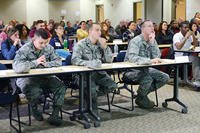The Navy's top enlisted Sailor, Master Chief Petty Officer of the Navy Mike D. Stevens, was on hand to distribute the first electronic tablets to the Navy's newest recruits at Recruit Training Command (RTC) Great Lakes, April 7. The launch of the eSailor initiative is a pre-pilot, beta testing two divisions of 70 recruits to help determine how well the device integrates into the training environment at RTC.
The tablets will contain RTC curriculum, including training videos, texts and access to professional development websites. The tablets will use technology already used in elementary through high schools across the nation and incorporate the RTC curriculum, creating a seamless educational transition from civilian to Sailor.
Currently, recruits receive over 100 hours of classroom and applied training. Much of this curriculum will be included on the tablet for recruits to access and study. For training purposes, the tablet for the pre-pilot will include Navy-owned RTC curriculum, a digital version of the Bluejacket's Manual, and various other training courses.
Stevens said the distribution of tablets to recruits which is part of the larger eSailor initiative will help the Navy "To be relevant in the world that we live in today, to be a Navy of the 21st century, we must embrace this technology and we can't let things like security and cost and all that kind of stuff drive the decision. We've got to learn to lead and manage through that. I'm not saying they're not challenges, but to say we're not going to do this is unacceptable. We have to figure it out."
The beta test at RTC will help determine if the e-Sailor initiative can work throughout the fleet.
Stevens wants all sailors to have tablets in order to better manage their careers, training, and the administrative demands of their jobs. He said that he would like to see ships outfitted with Wi-Fi access so that sailors can be better connected, a step that he has called essential to making sailors' jobs easier. Stevens didn't say if sailors would have the same level of access to the Internet when they're underway as they do ashore.
Sailors' demands for personal computers and Internet access is constant while underway. Ships have limited broadband, and mission-related needs are given priority access, while personal Internet use for keeping in touch with family, paying bills or browsing social media, is limited or restricted entirely.
In the future, Stevens said the goal is to have all sailors outfitted with digital access, whether through a smart phone or tablet or an application that connects to Navy software. But he acknowledged it will be tough to do for 400,000 people, and much work remains.





